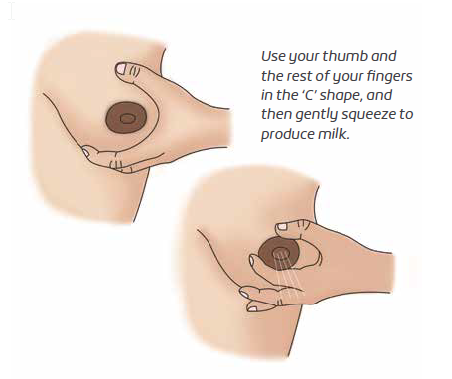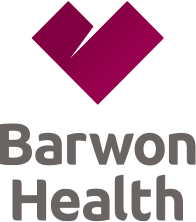Expressing breast milk
There are many reasons why lactating mums wish to express their breast milk and/ or store it. Sometimes a mother is separated from her baby or finds that it is very difficult or impossible to breastfeed. Other reasons may include concerns about breastfeeding in public; as a temporary approach while trying to increase breast milk supply or when planning return to work.
Expressing milk means squeezing milk out of your breast. You can express by hand or with a breast pump. Different pumps suit different women, so ask for information to compare them. Be sure to wash equipment after each use with hot soapy water, rinse well and dry on a clean surface. If your baby is unwell or premature ask for advice about sterilising the equipment.
Why express milk?
If you express milk, your baby will still be able to have mum’s milk even if somebody else is feeding them. This may be useful if you are away from your baby or returning to work. It’s best to wait until your baby is a little older before regularly expressing milk for your partner to feed your baby, so you have a chance to get feeding going well first.
Why express by hand?
• If your breasts feel uncomfortably full.
• If your baby isn’t suckling well but you still want to give him /her mum’s milk.
• If you don’t want to buy or use a pump to express milk.
• In the first few days it is easier to express by hand.

How to express milk by hand
- Have a clean container to collect milk.
- Cup your breast and feel back from the end of the nipple to where the texture of your breast feels different.
- Using your thumb and the rest of your fingers in the C shape, gently squeeze this area - this shouldn’t hurt.
- Release the pressure and then repeat again and again, building up a rhythm. Avoid sliding your fingers over the skin. At first, only drops will appear, but just keep going as it will help build up your supply. With practice and a little more time, milk will flow freely.
- When the flow slows down, move your fingers round to try a different section of your breast and repeat. When that flow slows down, swap to the other breast. Keep changing breasts until the milk is dripping very slowly or stops altogether.
- If the milk doesn’t flow, try moving your fingers slightly towards the nipple or further away, and try a gentle breast massage.
Expressing for premature or ill babies
If your baby has to stay in hospital, it is important to start expressing your milk as soon as possible after your baby is born. In order to ensure that you produce plenty of milk, you need to express at least eight times over 24 hours, including during the night. Ask the hospital staff about holding your baby in skin-to-skin contact. This can help with bonding and keeping up your milk supply. If you are freezing milk because your baby is premature or ill, ask the staff caring for your baby for advice.
How do I store breastmilk?
- Milk may be stored in any container. You may use a baby bottle, ice cube trays, small plastic containers or special breastmilk storage bags. Containers should be washed in warm soapy water, rinsed and air dried.
- Always label your milk with the amount and date.
- If you plan to freeze the milk do so within 48 hours of expressing it.
- If you add fresh milk to frozen milk, chill the fresh milk first
You can keep breastmilk for:
- Three days in the back of the fridge (at four degrees or less). Freeze before 48 hours.
- Two weeks in the freezer of a single door fridge/freezer.
- Three months in the freezer of a two door fridge/freezer.
- Six to 12 months in a separate freezer (-18 degrees or lower).
Use of expressed breastmilk:
- Milk may be kept at room temperature (up to 26 degrees) for six to eight hours (fridge preferred).
- Use milk defrosted in the fridge within 24 hours.
- Use milk defrosted in warm water within four hours (refrigerate once defrosted).
- Never refreeze defrosted milk.
- Discard any milk in contact with saliva.
- Heat milk only once and discard any unused milk immediately.
- Never use a microwave to heat milk – there is a danger of burns due to uneven heating and it destroys some of the nutrients in the milk.
- Breastmilk can be warmed by placing the bottle or cup in a separate cup containing very hot water (near boiling). Test the temperature of the warmed breastmilk with a few drops onto your inner wrist – it should feel neither hot or cold.
Last Modified: Thursday, 25 July 2019
Related Links
